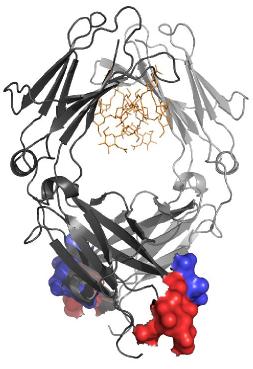New generations of monoclonal antibodies based on the Fc-fragment of IgG1 – loop engineering and library design
SUPERVISOR: CHRISTIAN OBINGER
Project assigned to: CHRISTOPH HASENHINDL
Background.
Monoclonal antibodies (mAbs) are the most successful biologically produced therapeutics today. They are applied for the treatment of many different diseases, including cancer, autoimmune diseases and infectious diseases. New generations of engineered mAbs with improved properties are being developed within the Christian Doppler Laboratory for Antibody Engineering that is a joint project between the Departments of Chemistry and Biotechnology at BOKU and f-star. Upon using the Modular Antibody Technology of f-star new additional binding sites will be introduced into antibodies and antibody fragments by engineering the non-CDR loops of constant or variable domains (Wozniak-Knopp et al., 2010).
For the folding of an immunoglobulin domain, it is important that the β-sandwich structure of the two interacting antiparallel β-sheets can form correctly. The β-sandwich is a very robust and highly conserved scaffold able to accommodate loops of different length and sequence without losing its overall structure (Batori et al., 2002).
Based on these observations we aim at mutating the loops AB, CD and EF that connect the β-strands of the CH3 domain in order to select for loops that form to a new, engineered target binding site while still maintaining the overall structure of the domain. We shall synthesize, test and characterize single clones and libraries that are constructed with these designed loop sequences in terms of structure and stability on the one hand, and efficiency in generating specifically binding Fcabs (i.e. antigen binding Fc-fragments) on the other hand.
Aims and methods.
 We aim at redesigning the loops of the CH3 domain of the Fc-fragment to create new functionalities. Two strategies will be followed, namely (i) rational design and (ii) random mutagenesis:
We aim at redesigning the loops of the CH3 domain of the Fc-fragment to create new functionalities. Two strategies will be followed, namely (i) rational design and (ii) random mutagenesis:
(i) Creation of a large library of protein loops extracted from the protein database that could be plugged on the selected framework and then selected or discarded based on the compatibility they have with the rest of the structure and within themselves (in cooperation with Luis SERRANO at the Center for Genomic Regulation, Barcelona, Spain). The strategy is to extract all loops in the database in a way that they all include a residue on each side corresponding to regular secondary structure elements (stem part of the loop). All the loops are then clustered in families attending at the end-to-end distance of the stem residues and on the RMSD between the stem residues and the first and last loop residues. For each loop in the structural classes the local energy will be computed to distinguish loops that are stable on their own (equivalent to canonical loops) from those that are stabilized by interactions with the rest of the protein. The ones with the best local and overall energy will be selected. In the same manner we aim at predicting the positions that can be mutated and will not disturb the loop structure, thereby improving the overall quality of Fcab libraries.
(ii) In order to maintain a high degree of diversity, which should in turn have the potential to yield well-folded and well-binding Fcabs, we will base our approach not only on single discrete stem sequences but rather on libraries of stem sequences made up from a mix of consensus residues identified from the loop libraries. From yeast display libraries with loops sitting on totally randomized stem sequences, favorable amino acid residues in the stem positions will also be identified using in vitro directed evolution strategy using error prone PCR. The resulting library will be cloned into a Saccharomyces cerevisiae surface expression vector that allows expression of the Fc-gene as a fusion protein. The library will be characterized by either analysing binding to generic ligands or by application of an heat shock and selection of stable (structurally intact) variants. In both cases it should be possible to find out loop lengths that are preferred over others for the specific loops AB, CD and EF and favor these loops in the next library design. Also, the position of the loops, i.e. where to exactly place the randomized part of the sequence in the Fc is expected to be derived as an outcome of this approach.
Interesting variants resulting from either molecular modelling or random mutagenesis will be cloned and expressed in and purified from Pichia pastoris and characterized with respect to their biochemical/physical (structural integrity, conformational and thermal stability) and biological properties (binding to generic ligands). Methods will include electronic circular dichroism, differential scanning calorimetry, isothermal titration calorimetry, size-exclusion chromatography, ELISA, FACS, surface plasmon resonance and biolayer interferometry.
Batori, V., Koide, V., Koide S. (2002) Exploring the potential of the monobody scaffold: effects of loop elongation on the stability of a fibronectin type II domain. Protein Eng. 15, 1015-1020
Wozniak-Knopp, G., Bartl, S., Bauer, A., Mostageer, M., Woisetschläger, M., Antes, B., Ettl, K., Kainer, M., Weberhofer, G., Wiederkum, S., Himmler, G., Mudde, G. C., Rüker, F. (2010) Introducing antigen-binding sites in structural loops of immunoglobulin constant domains: Fc fragments with engineered HER2/neu-binding sites and antibody properties. Protein Eng. Des. Sel., 1-9
